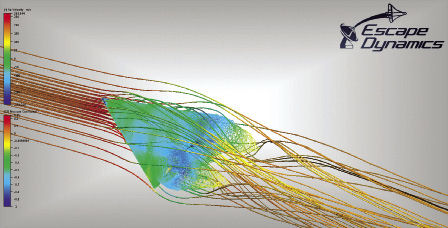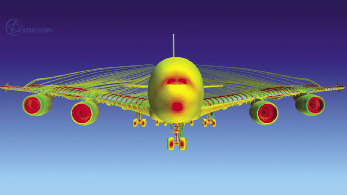December 4, 2001
By Kenneth Wong
How big is the problem of big data in simulation? I posed that question to Sanjay Angadi, a senior product manager of ANSYS. He replied, “I’ve heard people say, ‘Every time I open a large model, I should go make coffee.’ Others joke, ‘I’ll click Open on Friday and come back on Monday.’”
 A rendering of Escape Dynamics’ concept design for a launch vehicle. The company aims to develop the first single-stage-to-orbit reusable vehicle. Image courtesy of Escape Dynamics. |
The problem is especially prevalent in aerospace. Colorado-based Escape Dynamics aspires to develop the first single-stage-to-orbit reusable vehicle. Dmitriy Tseliakhovich, Ph.D., the company’s co-founder, CEO and CTO, explains that the big data in aerospace “often corresponds to large number of degrees of freedom and large number of system components that need to be simulated and optimized. This leads to a demand for a large number of simulation runs and the ability to analyze, store and share data.”
One way to bypass the problem is to tackle your design in piecemeal, to analyze it at the more manageable subassembly or part level. For a time, that was a perfectly legitimate solution. But more recently, manufacturers have begun to consider system-level simulation—even more ambitious than mechatronics in scope and scale—as the ideal approach.
Leo Kilfoy, MSC Software’s general manager for engineering lifecycle management, observes that nearly all aerospace original equipment manufacturers (OEMs) practice system-level simulation. But because of the typical level of complexity in any aerospace vehicle, he says, “it is impossible to build such a vehicle without system-level simulation.”
The new approach advocates the treatment of all related parts as a whole. Therefore, it forces engineers to once more confront the digital data monster. How do you load, display, share and collaborate on gigabytes of simulation results—preferably without involuntary coffee breaks? It’s a conundrum that some are solving with a mix of remote visualization, lightweight file formats, and cloud streaming.
HPC is the Visualization Engine
“Before you can look at the results, even getting the model into the simulation program is a huge hurdle,” notes David Vaughn, vice president of worldwide marketing at simulation software maker CD-adapco. “That’s where the simulation software’s secret sauce—in STAR-CCM+’s case, the meshing and surface-wrapping methods—makes a difference.” (Editor’s Note: For more, read “The Ongoing Quest to Cure CAD-to-CAE Data Exchange Headache,” December 2013.)
In post-processing, Vaughn says, both employing a client-server architecture and enabling the use of distributed parallel processing improve display performance. For viewing simulation results, CD-adapco offers STAR-VIEW+, a free desktop application that lets you view and interact with simulation results.
With large data sets, the general practice is to keep the data in the cloud (private or public), then let users access it through the CAE program itself or a free viewer like STAR-CCM+ client. This method offers the advantage of high-performance computing (HPC)—usually far superior to a typical desktop. The visuals, therefore, can be rendered on the back end before they’re transmitted to the client app for display.
“A good example is visualizing the streamlines,” says Vaughn, referring to the indication of the flow direction of heat, air or fluid. Although the solver has done its calculation to simulate the scenario, “there’s still a numerical process required to display the streamlines with all the densities and pressures,” he adds. “It’s helpful to do that on the more powerful servers with distributed memory.”
Escape Dynamics uses Autodesk Simulation CFD and Simulation Mechanical to design and optimize the airframe of the vehicle, the engine and many other subsystems. “These tasks involve multiple people,” says Tseliakhovich. “We use a wide range of data visualization tools to analyze the results of virtual wind tunnel simulations, and benefited significantly from the new features of Autodesk Simulation CFD. The ability to visualize forces, pressure volumes, iso-surfaces and flow lines is exceptionally useful in the design process.”
Because the airframe is expected to house multiple subsystems inside (avionics, payloads, engine, etc.), small changes in the shape of the airframe have an impact on every other subsystem. For visualization, “the ideal scenario would be to enable continuous iteration and optimization process when the designer can evaluate changes across the entire system,” Tseliakhovich says. “This would clearly require both server-side simulations and server-side rendering of the resulting data.”
Keep the Data Where It’s Produced
ANSYS’ Angadi noticed that the most advanced customers sought relief from big data problems through a mixture of lightweight data formats, provisioning powerful CAE desktops dedicated for CAE/computational fluid dynamics (CFD), and remote desktop clients. Each has its own drawbacks—so a blend of the three, he says, seems to be the right approach.
 Vortice test results from Escape Dynamics’ early airframe. Because the airframe is expected to house multiple subsystems inside (avionics, payloads, engine, etc.), small changes in its shape can have an impact on every other subsystem. Image courtesy of Escape Dynamics. |
“By definition, lightweight data is meant to be a supplement to post-processing tools, not a replacement,” he continues. “Today, lightweight formats work well for remote interactive interrogation of surface data, but large-volume data (CFD) still poses some challenges. With file transfer, the challenge is to minimize the bandwidth requirements. With remote desktops, we discovered that anything more than a hundredth millisecond’s delay could be bothersome to users.”
(Editor’s note: ANSYS’s Angadi clarified that he was referring to a 100th millisecond round-trip latency. He said, “It is important to know that latency, bandwidth, and data transfer rates play a major role with remote 3D rendering, since they affect user perception of the cloud/HPC capability delivered to them.”)
According to Angadi, customers prefer to keep the data where it’s produced: on the HPC server. Keeping the simulation results physically close to the processors also cuts down on the data traffic. Advanced simulation and analysis programs are usually designed for client-server setup. Therefore, handling post-processing graphics on the HPC server offers similar advantages in visualizing the results. For those who need to view simulation results remotely, ANSYS offers integration to a lightweight viewer from VCollab as part of its collaborative simulation toolset.
Phillip Greene, SIMULIA’s R&D director for simulation visualization applications, notes that his firm’s Multi-Physics Results application, built on the 3DEXPERIENCE platform, utilizes a client-server architecture. “This architecture enables the data processing to be achieved in parallel, and the processing can be performed within the compute environment, where the large-result files are produced and reside,” he explains. “Performing data processing on the compute server negates any requirement to copy or move datasets to be accessible for visualization.”
With this approach, Greene points out, the software’s ability to deliver reasonable performance on slow networks is an advantage. The app accomplishes this by “only sending the necessary data to update the display, and to perform graphics manipulations on the local client,” according to Greene.
PLM-integrated Viewer
In 2010, PTC decided to break up its all-encompassing Pro/ENGINEER into smaller, modular programs branded as PTC Creo apps. In its current lineup, PTC Creo View serves as the company’s offering for enterprise-wide 3D data viewer.
“Today, you can publish simulation results ]from PTC Creo Simulate] in the PTC Creo format and distribute it to the company,” reports Brian Thompson, PTC’s vice president of product management, CAD segment. But companies are liable to use and manage simulation results produced in a variety of programs, including some from PTC’s rivals.
Will Kohler, PTC’s senior VP of product management, clarifies: “Simulation data files are proprietary for each simulation application. However, simulation results can be saved in standard file formats. If Windchill users are storing the simulation results in Windchill, they should be viewable with Creo View without any conversion. Storing the results in Windchill is a much more common use case, given the very large size of the data files.”
PTC Creo View is usually used for interacting with 3D CAD models without installing the authoring CAD programs. According to PTC, Creo View can handle massive assemblies, such as ships, airplanes or automobiles. It has proven itself with customer datasets with millions of polygons, and can handle up to 1 billion in interactive mode with good performance.
For manufacturers who use PTC Windchill to manage their engineering data, Creo View offers tight integration with the data-management system. The viewer is available as a desktop program, browser-based app or mobile app.
Subsystem View vs. System View
In aerospace, users prefer to have the option to visualize the entire system. But that doesn’t necessarily mean it’s something routinely done. By definition, system-level visuals involve too much data. If an engineer is trying to troubleshoot something in an analysis program, he or she will most likely analyze only the subcomponents that contribute to the problem. For example, electrical wiring information can safely be omitted when doing an airflow study of the outer surface.
“What I can tell you, based on what I’ve seen is, customers use many different methodologies based on the analysis type,” says ANSYS’ Angadi. “Common global and local modeling approaches include modeling subsections and substructures. But even so, at the subsystem level, the visualization challenges for post-processing and pre-processing are significant.”
Although a system-level view is not always required, it’s important that engineers are able to see how different input parameters are related to the subsystem under study. Escape Dynamics’ Tseliakhovich offers this example: “A change in wing geometry might cause a significant change in mechanical stresses experienced by the airframe. This is where large-scale multiphysics simulations and the ability to do server-side data management would be extremely helpful.”
CD-adapco’s Vaughn notes that generally speaking, however, “you need to have a tightly integrated organization to do” system-level simulation. Even among many Tier I suppliers and leading aerospace manufacturers, “tightly integrated” remains a work in progress or a vision to strive for—not yet a reality.
True Cloud Apps for Mass Consumption
Storing large data sets on engineers’ local machines is hardly an option, and most CAE code’s client-server setup demands cloud integration. But whether you choose private cloud (essentially an internal server or intranet) or public cloud (such as Amazon Web Services) may depend upon your firm’s size and IT capacity.
“Larger organizations typically have the infrastructure in place to fully support their software and hardware installations, and the desire to maintain full control of their data,” explains SIMULIA’s Greene. “Smaller organizations can see the benefits of a public cloud, which can provide access to extensive compute resources and can provide excellent configuration control to assure that their software solutions are running in an optimal fashion.” The Multi-Physics Results app is available for both public or private cloud deployment.
 CFD Analysis on an Airbus A380 with engines and landing gear. |
For engineers and designers already equipped with powerful desktops and advanced CAE software, visualizing CAE simulation results is well within their capacity. But the desire to share these results with non-engineers in collaborative projects—for example, sharing the heat-flow results of an aircraft model with public relations and marketing teams—demands lightweight viewers that can be installed on mobile devices and consumer PCs.
“Our ideal situation would be to keep the data in the cloud in a compressed format, and be able to give access to the data to the engineers who need it,” says Escape Dynamics’ Tseliakhovich. “Today, this functionality is limited, but with the work currently pursued by Autodesk, this challenge is going to be addressed in the very near future.”
MSC Software’s Kilfoy points out that SimManager, his company’s simulation process and data management system, employs multiple approaches for sharing engineering data in a secure collaborative environment: Web-based dashboards that provide the ability to drill down to specific information; rich-3D lightweight models, CAE results viewing, and post-processing viewable in a browser; and a strong application programming interface (API) to support access from client applications, including mobile devices.
If such a solution is not available, project team members may have to rely on JPG screenshots, 3D PDFs and AVI clips to communicate their findings. These media help to a point, but offer no interactivity. You won’t, for instance, be able to choose different types of stress results from a dropdown window in a movie file, or rotate a still image to inspect the results from another angle.
Because the tendency to host the source files and outcomes of simulation in the cloud (private and public) is already well-established, a cloud-hosted simulation data viewing and sharing solution seems like the most convenient approach. And as SIMULIA’s Greene points out, Software-as-a-Service (SaaS) is relatively easy to use, “with a user interface targeting the non-experts and literally no maintenance by the end users.”
Kenneth Wong is Desktop Engineering’s resident blogger and senior editor. Email him at [email protected] or share your thoughts on this article at deskeng.com/facebook.
More Info
Subscribe to our FREE magazine, FREE email newsletters or both!
About the Author
Kenneth Wong is Digital Engineering’s resident blogger and senior editor. Email him at [email protected] or share your thoughts on this article at digitaleng.news/facebook.
Follow DE





